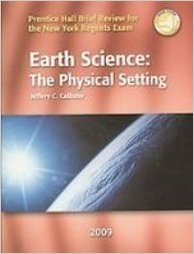
Earth Science: The Physical Setting
1st Edition
Jeffrey C. Callister
ISBN: 9780133200409
Textbook solutions
Chapter 1: Introduction to Earth’s Changing Environment
Page 4: Review Questions
Page 13: Practice Questions
Chapter 2: Measuring Earth
Page 20: Review Questions
Page 32: Practice Questions
Chapter 3: Earth in the Universe
Page 40: Review Questions
Page 53: Practice Questions
Chapter 4: Motions of Earth, Moon, and Sun
Page 62: Review Questions
Page 76: Practice Questions
Chapter 5: Energy in Earth Processes
Page 84: Review Questions
Page 95: Practice Questions
Chapter 6: Insolation and the Seasons
Page 104: Review Questions
Page 120: Practice Questions
Chapter 7: Weather
Page 128: Review Questions
Page 155: Practice Questions
Chapter 8: Water and Climate
Page 163: Review Questions
Page 175: Practice Questions
Chapter 9: Weathering and Erosion
Page 186: Review Questions
Page 196: Practice Questions
Chapter 10: Deposition
Page 204: Review Questions
Page 212: Practice Questions
Chapter 11: Earth Materials?Minerals, Rocks, and Mineral Resources
Page 222: Review Questions
Page 238: Practice Questions
Chapter 12: Earth’s Dynamic Crust and Interior
Page 245: Review Questions
Page 271: Practice Questions
Chapter 13: Interpreting Geologic History
Page 280: Review Questions
Page 296: Practice Questions
Chapter 14: Landscape Development and Environmental Change
Page 304: Review Questions
Page 318: Practice Questions
All Solutions
Page 186: Review Questions
Exercise 1
Result
1 of 1
1
Exercise 2
Result
1 of 1
1
Exercise 3
Result
1 of 1
2
Exercise 4
Result
1 of 1
4
Exercise 5
Result
1 of 1
As the length of time increases, the depth of soil generally increases (a direct relationship)
Exercise 6
Result
1 of 1
3
Exercise 7
Result
1 of 1
a temperature climate with alternating freezing and thawing with high humidity or moisture.
Exercise 8
Result
1 of 1
4
Exercise 9
Result
1 of 1
2
Exercise 10
Result
1 of 1
3
Exercise 11
Result
1 of 1
2
Exercise 12
Result
1 of 1
2
Exercise 13
Result
1 of 1
1
Exercise 14
Result
1 of 1
4
Exercise 15
Result
1 of 1
all erosion of sediments directly by gravity in mass movement.
Exercise 16
Result
1 of 1
3
Exercise 17
Result
1 of 1
1
Exercise 18
Result
1 of 1
2
Exercise 19
Result
1 of 1
3
Exercise 20
Result
1 of 1
1
Exercise 21
Result
1 of 1
pebbles.
Exercise 22
Result
1 of 1
3
Exercise 23
Result
1 of 1
1
Exercise 24
Result
1 of 1
2
Exercise 25
Result
1 of 1
2
Exercise 26
Result
1 of 1
4
Exercise 27
Result
1 of 1
Due to wind blows through the rock, the larger particles in the sand would be blown at the lower height and lighter particles in the sand will be at top. Hence when abrasion occurs, they get eroded more at the bottom than top.
Exercise 28
Result
1 of 1
2
Exercise 29
Result
1 of 1
3
Haven't found what you were looking for?
Search for samples, answers to your questions and flashcards

unlock
